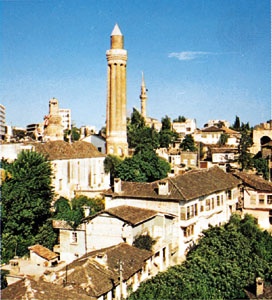Antalya
Turkey
Ancient Greek Attalia,
 city and Mediterranean port, southwestern Turkey, on the Gulf of Antalya. Attalia was founded as a seaport in the 2nd century BC by Attalus II, a king of Pergamum. It was bequeathed to the Romans by his successor, Attalus III. St. Paul and St. Barnabas embarked from the seaport on their evangelical mission to Antioch. The “Hadrian Gate,” a marble portal of three identical arches, was built to commemorate a visit by Hadrian in AD 130.
city and Mediterranean port, southwestern Turkey, on the Gulf of Antalya. Attalia was founded as a seaport in the 2nd century BC by Attalus II, a king of Pergamum. It was bequeathed to the Romans by his successor, Attalus III. St. Paul and St. Barnabas embarked from the seaport on their evangelical mission to Antioch. The “Hadrian Gate,” a marble portal of three identical arches, was built to commemorate a visit by Hadrian in AD 130.During the Middle Ages the city was a Byzantine stronghold and an important embarkation point for troops going to Palestine during the Crusades. It was captured by the Turkish Seljuq ruler Kay-Khusraw in 1207 and soon became the most important town and port of the region. Although it was first occupied by the Ottoman sultan Bayezid I in 1391, its incorporation into the Ottoman Empire was delayed until the late 15th century because of the disruption caused by the invasion of Timur (Tamerlane). In the tripartite agreement of 1917 for the postwar division of the Ottoman Empire among Italy, France, and the United Kingdom, Italy claimed Antalya and its hinterland. Italian troops occupied the district in 1919 but were driven out in July 1921 by Turkish nationalist forces.
With a subtropical warm climate and an abundance of ancient sites nearby, Antalya is the chief tourist resort on the Turkish Riviera. The old town, surrounded by fortified walls restored during Roman, Byzantine, and Seljuq periods, occupies the summit of a low cliff overlooking the harbour. Notable monuments in the town include an ancient tower, probably once used as a lighthouse, and a Seljuq religious college and mosque dating from 1250. Yivli Minare, a former Byzantine church converted into a Seljuq mosque, now houses the local archaeological museum. Pop. (2000) 603,190.
- nutrition
- nutritional disease
- nutritional supplement
- nutrition common microbes that
- nutrition, human
- Nuttall, George Henry Falkiner
- Nuttall, Thomas
- Nuttall, Zelia Maria Magdalena
- Nutting, Mary Adelaide
- Nu, U
- Nuu-chah-nulth
- Nuuk
- Nuussuaq
- Nuvolari, Tazio
- Nuwara Eliya
- Nuzu
- nuée ardente
- NVIDIA Corporation
- Nwapa, Flora
- Nyack
- Nyainqêntanglha Mountains
- Nyakyusa
- Nyala
- nyala
- Nyamulagira, Mount